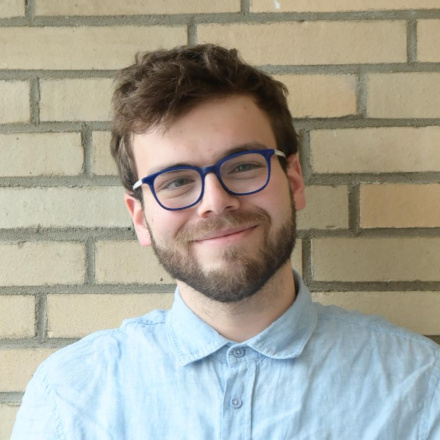Titus von der Malsburg
Junior Professor for Psycholinguistics and Cognitive Modeling at University of Stuttgart
Profiles:
Github
Google Scholar
e-Mail:
titus.von-der-malsburg@ling.uni-stuttgart.de
Address:
University of Stuttgart
Institute of Linguistics
Keplerstraße 17
70174 Stuttgart
News
- Conferences in the US: Until the authoritarian-style travel controls are lifted, our research group will sadly not be able to submit work to conferences in the US.
- Courses planned for the summer term 2026:
- Introduction to statistical data analysis and causal inference
- Acquisition and analysis of eye movement data (with Benedikt Ehinger and Judith Schepers)
- Research colloquium: Experimental and computational psycholinguistics (organized by Candy Adusei, Ondřej Drobil, and Qibi Wang)
- Introduction to statistical data analysis and causal inference
- Courses in the winter term 2025/26:
- Human sentence comprehension
- Psycholinguistics of neural language models (with Sebastian Padó)
- Human sentence comprehension
- New open access paper: Mézière, Yu, von der Malsburg, Reichle, & McArthur (2024). Using eye movements from a ‘read-only’ task to predict text comprehension. To appear in Reading Research Quarterly. https://ila.onlinelibrary.wiley.com/doi/full/10.1002/rrq.70023
Bio
I investigate how we make sense of language. How is each word that we hear or read combined with our understanding of the text so far? What sources of knowledge do we recruit in this process? And how are they combined, especially when they are in conflict? To answer questions like these, I use experimental and computational methods ranging from eye-tracking and event-related brain potentials to large-scale crowd-sourcing, corpus methods, Bayesian data analysis, computational cognitive modeling, and large language models.
I am a tenure-track professor at the Institute of Linguistics at the University of Stuttgart. Previously, I held postdoctoral positions at University of Potsdam, UC San Diego, and the University of Oxford. I earned my PhD in Cognitive Science at the University of Potsdam where I also served as a visiting professor for two years. In addition to my academic work, I have worked as a software engineer, founded two companies, and collaborated with sound artists and composers at the intersection of science and art.
Research interests: Incremental sentence comprehension; reading comprehension, reading strategies, and scanpaths; syntactic ambiguity and ambiguity resolution; implicit linguistic gender biases; cue-based parsing, working memory, interference; locality and word order; expectation, prediction, surprisal, and information density; cognitive biases and bounded rationality; resumptive pronouns; dog whistles, plausible deniability, and social meaning; experimental methods, especially web-based and eye-tracking; corpus methods and neural language models; Bayesian and frequentist statistics; computational cognitive modeling, large language models.
Teaching interests: Human sentence processing, eye-tracking, Bayesian data analysis, corpus methods, large language models, web-based experimental methods, scientific computing, foundations of math.
Media coverage:
- New York Times (25.01.2020): She’s the Next President. Wait, Did You Read That Right?
- WNYC Studios, The Takeaway: America's weekday conversation (podcast, 29.01.2020): Could "She" Be President? A Look at Pronoun Bias in Politics
- MIT News (08.01.2020): “She” goes missing from presidential language. Also reported by ScienceDaily, AAAS EurekaAlert!, and Phys.org.
- Kunstjahr 2013 – Die Zeitschrift, die Bilanz zieht, Lindinger + Schmid. Article about my science/art cross-over project with sound artist Christoph Illing.
My name is a bit unusual which may cause confusion. To clarify: My first name is “Titus” and my last name is “von der Malsburg”. Despite common misconceptions, my last name should not be written as “Von Der Malsburg”, just “Malsburg”, or “van der Malsburg” (with Dutch “van” instead of “von”). Nor should “von der” be treated as a middle name. For historical and practical reasons, it’s customary to list my name alphabetically under “M” not “v”. In BibTeX entries, it’s best to write {von der Malsburg}, Titus and to include the field sortname = {Malsburg} when I’m the first author of a publication.
Lab
Members of my group are: Dr. Anna Prysłopska, Candy Adusei, Ondřej Drobil, and Qibi Wang (in the order in which they joined the group).
Together, we use a range of tools to conduct our research, including a TRACKPixx3 eye-tracker (2 kHz, binocular, similar to EyeLink 1000+) and three GazePoint trackers (two GP3 HD and one GP3). The latter are primarily used for eye-tracking education.
Working with us
If you are interested in joining our group as a doctoral student or postdoc, we encourage you to get in touch. Before doing so, we kindly ask that you conduct some research to see if your research interests align with ours. Our group emphasizes high technical quality, robustness of research findings, replicability, and reproducibility. This means that lab members are expected to possess or to develop proficiency in statistics and in software tools such as Rmarkdown or LaTeX/Knitr, and version control systems like git. Basic programming skills in Python or R will also be beneficial. When contacting us, ensure that your message explicitly connects your research interests with the specific research conducted in our group. This will help us better understand how you could contribute and thrive as a member of our team.
Blog
Better described as random technical notes, some of which are taken from our internal lab wiki.
- We use a plain GitHub repository for project and knowledge management (Feb 2025)
- How we do weekly updates (Feb 2024)
- A guide and template for self-hosted experiments (Nov 2023)
- Cohen’s d in simple linear regression models (Sept 2022)
- How to calculate worker compensation for Amazon Mechanical Turk (Dec 2016)
- Latin square designs in Ibex experiments (Feb 2016)
- Bayesian mixed-effects models using MCMCglmm (June 2015, horribly obsolete because we now have Stan-based packages such as brms, rstanarm, and rethinking)
- Predict vs simulate in lme4 (May 2015)
Software
Science fundamentally relies on open source / libre software that prioritizes users’ needs over shareholders' interests. As such, we are committed to contributing to a robust software ecosystem developed and maintained by researchers for researchers.
For conducting experiments:
- Chamois: Easy stimulus presentation for eye-tracking experiments. Like (PC)Ibex but for eye-tracking.
- llm_surprisal: Simple tools for generating tokens with GPT2 (English), Bloom, or XGLM (multilingual) and/or calculate per-token surprisal. Made primarily for beginners and education. No programming needed.
- py-span-task: Python application for testing reading or operation span. Implements the recommendations by Conway, Kane, Bunting, Hambrick, Wilhelm, & Engle (Psych Bull & Rev, 2005).
- TEDview: A program for visualizing discrete temporal data, e.g., events taking place in an incremental dialogue system. See von der Malsburg, Baumann, Schlangen (2009) for details. Not actively maintained.
R packages:
- Scasim: Implements my measure for scanpath similarity along with some tools for data preprocessing and visualization. The measure is described in von der Malsburg & Vasishth (JML, 2011).
- Saccades: Detection of saccades and fixations in raw eyetracking data. Implements the velocity-based algorithm by Engbert & Kliegl (Vis Res, 2003).
- binomialCRIs: R package with functions for calculating and plotting binomial credible intervals. Developed for educational purposes.
- edfR: An R package for reading EDF files generated by EyeLink eye-trackers. Not actively maintained (since I’m no longer using EyeLink trackers).
Emacs packages:
- helm-bibtex: A bibliography manager for Emacs. With 450+ GitHub stars and 150K+ downloads my biggest open source success. Used by researchers around the world.
- guess-language.el: Emacs minor mode that detects the language you’re typing in. Automatically switches spell checker. Supports multiple languages per document.
- tango-plus-theme: Color theme for Emacs loosely based on the tango palette.
- mwk.el: Yet another Zettelkasten system for Emacs. This one tries to be simple and easy to use. I use this daily for my own note-taking needs.
- txl.el: Emacs extension that offers direct access to DeepL machine translation. Named in honor of the now-closed TXL airport in Berlin.
- helm-mu: Helm sources for filtering emails and contacts using mu, a maildir indexer.
- helm-dictionary: Helm front-end for quick dictionary access.
- helm-org-contacts: A helm source for address books in org-contacts format.
Publications
RSS feed: To receive notifications about new publications, right-click on the button “Publications as RSS feed”, copy the link, and import it into your RSS feed reader.
BibTeX: Click the button below to download a BibTeX file listing all my publications. This file can be imported into bibliography managers such as Zotero, Jabref, or Mendeley.
Journal articles
Manuscripts
Conversational principles such as Grice's maxim of Quantity (roughly: be informative) are essential to our ability to communicate efficiently. Due to their ubiquitous nature in language-based communication, they may interfere in a large variety of other cognitive tasks which at first glance may not seem linguistic in nature. Here, we report three experiments that investigated the role of the Quantity maxim in the overconfidence bias in interval estimation (also referred to as overprecision). Experiment 1 (N=309) used a chat paradigm to bias participants against providing the most informative answer, as would be required by Quantity, resulting in a reduced overprecision bias. Experiment 2 (N=322) and Experiment 3 (N=309) tested whether this effect depends on explicit social cues, specifically, the presence of a conversational partner. Both experiments replicated Experiment 1 in the absence of a full conversational context, thus showing that linguistic cues alone are sufficient. Taken together, these results suggest that conversational principles – extensively studied in linguistics, but largely ignored in research on cognitive biases – play an important role in the overprecision bias and, as we argue, likely in other biases as well.
Existing corpus-based measures of morphological productivity all exhibit problematic dependences on sample size. Here, we show that another measure, the Shannon entropy of a type frequency distribution, has a different relationship with sample size, one that allows meaningful analysis in a wider range of circumstances. Once the sample gets large enough, entropy stabilises at interpretable values. In contrast to the existing measures, this behaviour allows the entropy scores of samples of different sizes to be sensibly compared. Entropy's stabilisation is due to an intriguing property of type frequency distributions, namely their self-similarity: even when sample size changes, the shape of the distribution itself does not. We also include empirical comparisons of entropy to three standard productivity measures—type count, potential productivity, and S—and provide a tentative conceptual validation of entropy as a productivity measure, showing with a Bayesian regression model that entropy picks up on important aspects of what it means for a morpheme to be productive.
Proceedings articles
Other publications
For conference abstracts and artistic works see my full CV (PDF).



